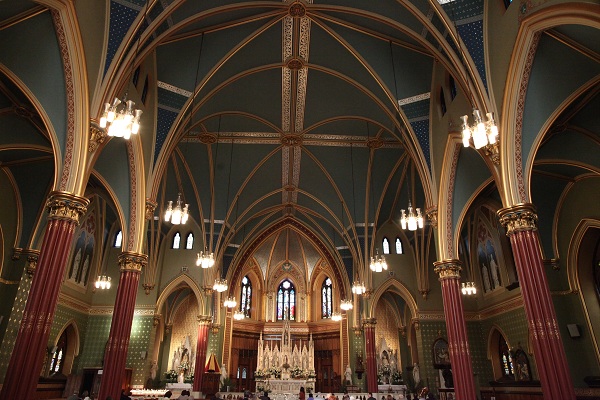
As I was browsing the wide web of
(dis-)information today, I happened across some photos of a recent church restoration on a Connecticut Latin Mass society's blog. The Basilica of Saint John in Stamford, Connecticut, a late
Victorian parish church in the Gothic revival style, had suffered from that
all-too-common bout of whitewashing that church vandals in pointy hats imposed
upon their flocks around the time of Vatican II. In this case, the wall murals
in the sanctuary had actually been painted over in white a few years before the
Council. After their pastor decided to peel away the 21 coats of whitewash and
restore the murals a few years ago, the church went beyond that and coated the
whole interior in an array of rich color; a project which finally finished this
past April. In an article from the Stamford Advocate, the pastor, Monsignor
Stephen DiGiovanni, was quoted saying, “It was looking like a bowl of vanilla
ice cream. Now it looks magnificent.” For my own part, I couldn’t agree more.
 |
| Saint John's in 2009. |
In fact, I actually loathe the look
of whitewashed church interiors. Here I should explain before some scandalized
soul out there accuses me of hating the purity that brilliant white represents.
You see, nothing screams the iconoclastic vitriol of the Protestant reformers
who scoured the frescoes which adorned the churches of their medieval forbears,
or the frighteningly bad taste of the Rococo designers with their temples modeled after wedding-cake palaces, quite like an all-white church. It’s one
thing for a Gothic church to embrace the simplicity of bare, grey stonework, as
many of the ancient cathedrals now stand today. But the “purity” of our modern
stuccoed abominations, as Pugin would say, is more likely a flimsy excuse for a
darker reality: that the designers lacked the talent or imagination to do
anything else.
Nearly every church in medieval
England, from the cathedral to the humble parish, was adorned with beautiful
wall paintings. These images, like the statues and stained-glass windows that
accompanied them, served to tell the stories of the Holy Gospels and the saints
to a people who couldn’t read. The colors brought vibrancy to a harsh world
that was regularly beset by disease, famine, and war. Master painters were
aided in their work by the entire community of the faithful. Some painters were
even women. Painted church interiors had been a part of the medieval English
parish tradition for five hundred years; in other words, as long as there were
stone churches in England at all. There are surviving fragments of wall
paintings on the Continent that are even older.
 |
| 15th century painting of the Harrowing of Hell at the church of Saints Peter and Paul in Pickering, Yorkshire. See here for more. |
 |
| A Doom (Last Judgment) painting at the church of Saint Thomas Becket, Salisbury. It was repainted during the Victorian Gothic revival. |
All this changed with the arrival of
the Reformation. Henry VIII’s reforms were relatively modest. He “only” ordered
the destruction of saints’ reliquaries, such as the famous shrine of Saint
Thomas Becket in Canterbury. With the accession of his heir, the boy king
Edward VI, his radical Protestant advisors could begin the war on imagery and
color itself in earnest. By the end of his short reign, nearly every church in
the country had their walls whitewashed or even sometimes torn out. English
glassmakers actually forgot how to make stained-glass until the Gothic revival in
the 19th century.
The Catholic world regrettably followed
suit. On the Continent, even Catholic rulers viewed their Gothic churches not
as treasures from a venerable era, but garish vestiges of medieval barbarism. For
instance, in the later 1600’s, Louis XIV oversaw the whitewashing of Notre-Dame de Paris. A few centuries of paintings, tombs, and statues were a small price
to pay for bringing one of the great Gothic cathedrals of medieval France “up
with the times”, so they thought. Even the vast majority of the stained-glass
windows were removed. Thankfully, the Gothicist Viollet-le-Duc amended the
windows during his twenty years of restoration work in the 19th
century, but the walls remain a uniform shade of drab grey to this day. The
very fact that so many Gothic cathedrals remain colorless, whether by the
ravages of time or vandalism, has probably been part of the reason why modern
churches built in the Gothic style usually have plain white walls.
The
Solution
It’s easy to despair and assume that
there are simply no contemporary artists with the talent and training to create
larger-than-life wall frescoes and mosaics for our undecorated churches. The
assumption is both false and deadly, and has probably has led to many a
classical artist surrender and take up a “real job” due to lack of demand for
their skills. I’d like to assemble a directory of artists trained in
medieval-style iconography, but even then, many churches won’t be able to
afford their expertise. In the meantime, a simple application of color, and
perhaps some geometric decorations, can still bring the drama of the medieval
imagination to your neighborhood parish.
The first example that comes to mind
is the very church where I was baptized, Our Lady of the Atonement in San Antonio, Texas. To see it today, it’s hard to believe the walls and ceiling
were originally white. That was long before I ever visited it, so I’ve only
seen the original white scheme in pictures. But since then, the interior has been
painted in a spectacular arrangement of red, blue, and gold, recalling such
fantastic schemes as the Sainte-Chappelle in Paris (also thanks to the restorative
work of Viollet-le-Duc). It’s very fitting that such a church’s painting scheme,
combined with its rood screen, recalls the majesty of the pre-Reformation
world, since Atonement was one of the first “Anglican Use” churches in America;
that is to say, one of the first communities specially created for former
Anglicans and Episcopalians to reconcile with Rome.
 |
| Note how the ceiling and sanctuary wall are enhanced with simple latticework. |
Objection 1.) “I’d like to introduce
a new painting scheme to my church, but the rich old trustees won’t go for it.
It’s simply too radical.” If a wholesale repainting of the church is too
daunting or too shocking for an old congregation stubbornly set in their ways,
one alternative is to experiment with only a small section. There’s a fine
instance in the apse of Saint Mary Cathedral in Austin, Texas. This Gothic
revival church has white walls in the nave, but the space around the high altar
is set apart with a distinctive wallpaper pattern along the walls and is topped
with a stunning blue ceiling studded with stars, making it clear that the high
altar is the axle where heaven and earth are conjoined.
 |
|
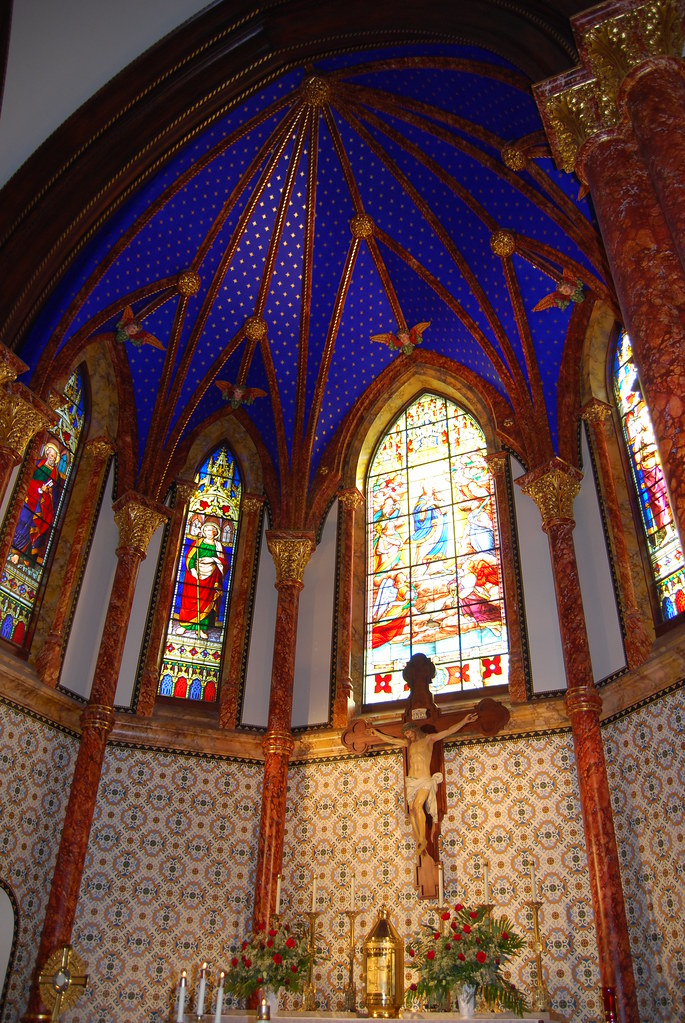
Objection 2.) “Your examples so far,
while splendid, are quite dark and brooding. They would turn off newcomers to
our church by appearing too foreign and cultish.” I’m still unconvinced of this
argument’s validity, but it gives me the opportunity to mention another Texas
treasure. If you go out to the small towns settled by 19th-century
German, Czech, and other European immigrants, you’ll be able to see quite a few
Victorian churches painted in bright colors reminiscent of Easter eggs. It’s a
unique synthesis of the Gothic revival and ingrained Rococo sensibilities. As
with Saint John’s in Stamford, the 1950’s struck and some of these painted
churches received a whitewashing in the name of modernization, then were
subsequently restored.
I'll close with a few links and more photos of painted churches. Next up: painted exteriors!
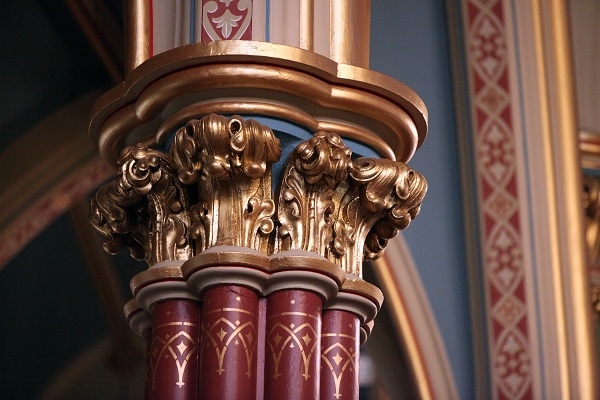 |
| Detail of a column at Saint John's, Stamford. |
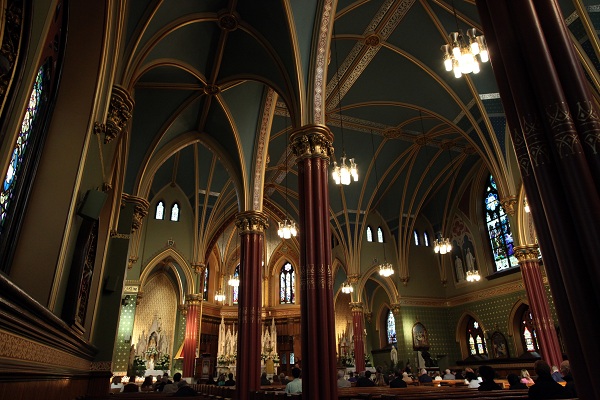 |
| Saint John's, Stamford again. |
|
|
|
|
 |
| The latticework of the ceiling at Our Lady of the Atonement in San Antonio, representing the net of the Gospel. |
 |
| The resplendent Lady Chapel, also at Our Lady of the Atonement. |
|
|
 |
Fantastic HDR rendering of Saint Mary's in Austin, contrasting the decorated apse with the white nave.
|
 |
| Saint Mary in High Hill again. |
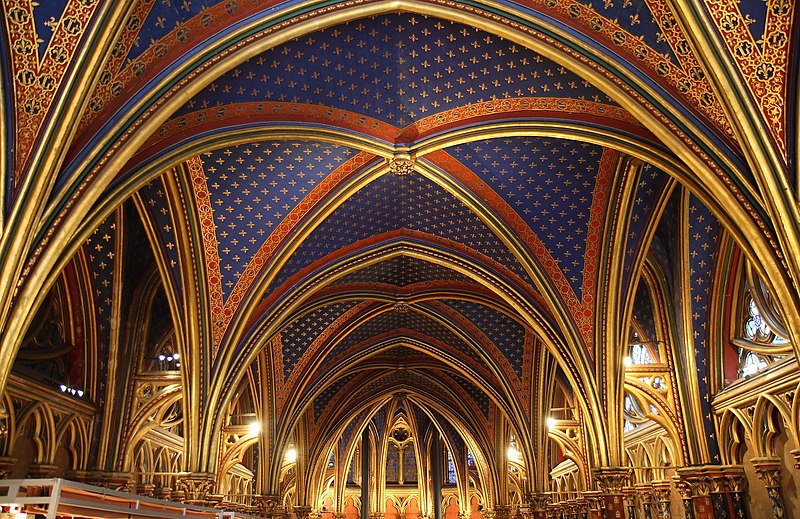 |
| It would finally be remiss not to post a photo of the Sainte-Chappelle, but this is worth an article in itself! |


















Excellent. Keep up the great work.
ReplyDeleteI'd love to hear your opinion of medieval Cistercian architecture.
ReplyDeleteOne white church I particularly love, though, is the Ottobeuren Abbey. I feel it actually uses white as a color instead of the default when creativity is lacking. I grew up in a whitewashed church (and color wasn't the only thing lacking). I can't really say I miss that building, despite the beautiful, though rather simplistic, depiction of the Transfiguration on the 25ft tall apse.
ReplyDeleteI've seen remnants of painted walls in a room in the cathedral of Toledo. Very impressive!
ReplyDeletehttps://fbcdn-sphotos-f-a.akamaihd.net/hphotos-ak-ash4/318258_10150982688580695_277536582_n.jpg
https://fbcdn-sphotos-d-a.akamaihd.net/hphotos-ak-prn1/543169_10150982689280695_1890169792_n.jpg
https://fbcdn-sphotos-a-a.akamaihd.net/hphotos-ak-ash3/575138_10150982689900695_1798290581_n.jpg
https://fbcdn-sphotos-g-a.akamaihd.net/hphotos-ak-ash3/181381_10150982690500695_1825950982_n.jpg
I agree with a lot of your comments. In fact, I agree with your point, but at the same time I am reminded of a great quote:
ReplyDelete"No one has ever been accused for not providing ornaments, but for those who neglect their neighbor a hell awaits with an inextinguishable fire and torment in the company of the demons. Do not, therefore, adorn the church and ignore your afflicted brother, for he is the most precious temple of all."
St. John Chrysostom
Charlie Baran
Charlie, let's look to our Fathers in the Middle Age. In that age everyone give the elemosyne (what is the English word? I'm Italian) to the poors, but this didn't forbided to built that wonderful and giving glori to God temples. We aren't pauperists
ReplyDeleteWe aren't pauperists. Elemosyne and beautiful churches building don't exclude each other. Look at the monks. Rule of Saint Benedict prescribes (it. prescrive) that the monks give the extra production, food, grain, and other to the poors. And the monasteries were very important economic centres, that transformed the area where they settled. The ours. The Latins. The activities of the Order of Saint Benedict were not all performed by Greek (and so then "Orthodox") monks, as I read in my Italian Enciclopedia Treccani, at the topic "Civiltà Bizantina". You can see it at treccani.it
ReplyDeleteSo I humbly suppose that what Chrysostome says is better directed to Byzantines than to Latin Catholics as we.
*the ours. The Latin ones.
P.S. Sorry for my bad English
Hi James,
ReplyDeleteI found your site while looking for some photos of repainted Gothic churches and have since read and enjoyed many more of your articles. I recommended you on my blog, where I frequently discuss Gothic art and architecture, specifically gargoyles. Keep up the great writing.
Alexandra
Beautiful photos! We would recommend a visit to the Joan of Arc memorial on the hill behind Rouen at Bonsecours and Basilica Notre-Dame next to it. The Basilica's interior is a Victorian gothic wonder. Vintage postcards led us to it and the tale of Isobelle Romee, remarkable mother of Joan. More and photos here.
ReplyDeletehttp://www.normandythenandnow.com/a-mothers-love-faith-and-joan-darc/
Check this church out, in York, England
ReplyDeletehttp://allsaints-northstreet.org.uk
Best wishes
TanyaJ
Thank you so much for posting this! I am currently working out a color & pattern scheme for my 1875 gothic revival church here in Baltimore. Your article has very much helped me without further reluctance decide the way to proceed!
ReplyDeleteIt will always be odd to me to see the "new Mass" said in Gothic-revival/Medieval style churches that were obviously designed with focus on the high altar in mind. Painted ceilings, walls, statuary, all were adjuncts and compliments TO that high altar - which now (if even still there) serves as a "pretty backdrop" to the "table".
ReplyDeleteModern gothic revival is a complex subject and one very close to my heart. Much is of the aesthetic accuracy is now lost. The Victorians knew how to emulate the true order of medieval decorations through design and colour.
ReplyDeleteThe was a grammar and order in which colours wold be arranged. Certain colours could not be haphazardly placed next to the wrong hue. All colours were separated with a neutral charcoal black, dirty white, cream or gold. These principals were derived from medieval heraldry.
Pugin, Crace, Bodley, Burges and other notable Gothic revivalists chose their own decorators who were adept in the art of duplicating medieval colouring. This was a skill which was inherited from the middle ages right up until the 1960s until faith and money declined.
These days there is a very slight recovery in gothic Churches. I worry that some of of the enusiasim directed at conserving or reproducing gothic art in churches may be carried out by those that are not qualified or who are technically ignorant on the issue of Gothic revival medievalism.
www.artconserved.co.uk